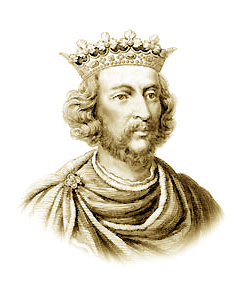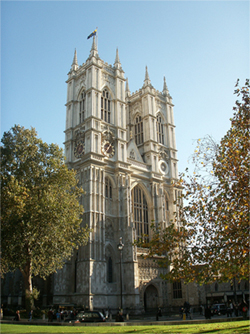King Henry III
 By the time the nine-year-old Henry III came to the throne, little was left of the Angevin empire in France and England was in a state of civil war with London in the hands of rebel barons making preparations to place France's Prince Louis upon the English throne. Because of all this, Prince Henry was crowned hurriedly at Gloucester Cathedral just 10 days after his father's death on the 20th of October 1216. Because King John had lost the crown jewels, a bracelet belonging to Henry's mother Queen Isabella was used in place of the Crown and the ceremony was performed by the French born Bishop of Winchester. William Marshal Earl of Pembroke was appointed as Regent and it wasn't too difficult a task for this well-respected man to re-establish order owing to the fact that with the death of King John, much of the resentment of the English barons had evaporated. Marshall managed to defeat the rebels in 1217 bringing the Civil War to an end and causing Louis to renounce his claim to England. Henry was crowned once again but this time with great pomp and circumstance at Westminster Abbey in the year 1220. Right: Henry III as depicted in Cassell's History of England 1902
By the time the nine-year-old Henry III came to the throne, little was left of the Angevin empire in France and England was in a state of civil war with London in the hands of rebel barons making preparations to place France's Prince Louis upon the English throne. Because of all this, Prince Henry was crowned hurriedly at Gloucester Cathedral just 10 days after his father's death on the 20th of October 1216. Because King John had lost the crown jewels, a bracelet belonging to Henry's mother Queen Isabella was used in place of the Crown and the ceremony was performed by the French born Bishop of Winchester. William Marshal Earl of Pembroke was appointed as Regent and it wasn't too difficult a task for this well-respected man to re-establish order owing to the fact that with the death of King John, much of the resentment of the English barons had evaporated. Marshall managed to defeat the rebels in 1217 bringing the Civil War to an end and causing Louis to renounce his claim to England. Henry was crowned once again but this time with great pomp and circumstance at Westminster Abbey in the year 1220. Right: Henry III as depicted in Cassell's History of England 1902
 Henry was of a short plump stature with dark bobbed hair. He sported a beard which went prematurely grey and was generally said to have a kindly face. He had a noticeable droop in his left eyelid. His character was more suited to domesticity and artistic pursuits than government. Although in this aspect he could be judged a bad king, in another way he was good for the country. His genuine love of the arts and his preparedness to foster them was great and he encouraged an influx of artists and craftsmen. It is mainly due to Henry that Westminster Abbey
Henry was of a short plump stature with dark bobbed hair. He sported a beard which went prematurely grey and was generally said to have a kindly face. He had a noticeable droop in his left eyelid. His character was more suited to domesticity and artistic pursuits than government. Although in this aspect he could be judged a bad king, in another way he was good for the country. His genuine love of the arts and his preparedness to foster them was great and he encouraged an influx of artists and craftsmen. It is mainly due to Henry that Westminster Abbey
was rebuilt and developed into the wonderful monument that we see today.
Left: Westminster Abbey
Henry also had a fascination with exotic animals and built a Leopard house at the Tower of London in 1237 and not long after a menagerie also at the Tower of London. In part this was to house the first elephant ever to be brought to England which was a gift to Henry from France's King Louis IX in 1255. In this aspect Henry was following in the tradition of his great-grandfather Henry I who had kept a collection of camels leopards and lions at Woodstock in Oxfordshire. - King Henry III Part 2


